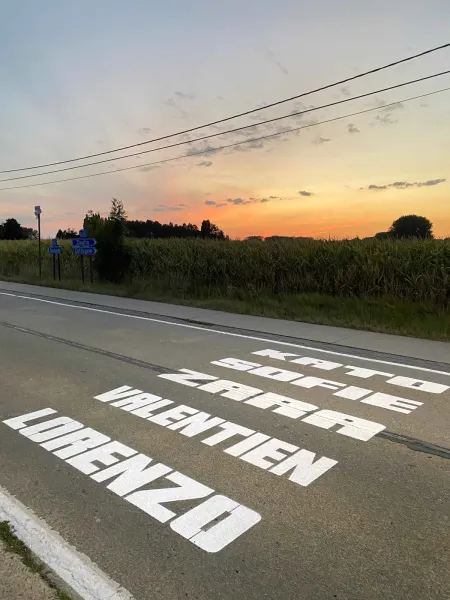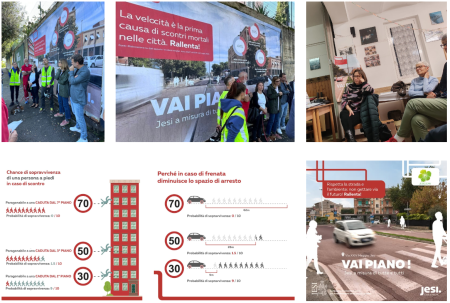Public authorities

Thursday, May 29, 2025
The 'EuroTarn' Association was set up in 1997 (by myself) to encourage young people to discover the countries of the European Union, and thus learn about other European cultures and languages. The association's motto from the outset was to inspire young people to 'move in a moving world'.
Between 1997 and 2007, we developed Universities exchanges with various regions. In 2007, we created some actions to attract young people (in the Tarn area) to be more interested in Europe, and to develop their 'European citizenship' and their feeling of belonging to a same European community; And Road safety was one of the very first topic that we decided to tackle with the very first European day of Road safety in April 2007. Therefore we decided to run campaigns to talk about Road safety and... Europe, and we decided to start to visit schools to educate young people.
Between 1997 and 2007, we developed Universities exchanges with various regions. In 2007, we created some actions to attract young people (in the Tarn area) to be more interested in Europe, and to develop their 'European citizenship' and their feeling of belonging to a same European community; And Road safety was one of the very first topic that we decided to tackle with the very first European day of Road safety in April 2007. Therefore we decided to run campaigns to talk about Road safety and... Europe, and we decided to start to visit schools to educate young people.

Monday, May 26, 2025
Road crashes is a major societal problem worldwide, especially in cities where pedestrians, cyclists and motorcyclists are highly exposed and vulnerable in case of a collision. The new policy of city-wide 30 km/h speed limit is intended to ensure vulnerable road users’ safety accounting for 70% of deaths in road crashes in urban areas in Europe.
Scientists urge continuously for lower speeds; however, speeding remains a model and sought behaviour among most drivers and riders, especially the young. The voices of vulnerable road users for less speeding remain weak towards our long-established car and speed-centred societies.
The National Technical University of Athens (NTUA) launched the innovative and original 30 Marathons in 30 months campaign (www.georgeruns30x30.com), aimed at promoting city-wide 30 km/h speed limit in all cities worldwide, as a key policy for safer, healthier and greener cities for all. The NTUA campaign was implemented by the internationally renowned NTUA Professor George Yannis, who is ranked 2nd in Europe and 9th worldwide in road safety science, and supported by the NTUA Road Safety Observatory (https://www.nrso.ntua.gr), a Centre of Research and Innovation Excellence on road safety with global recognition.
This impactful campaign represents a major shift towards a more human-centred approach to urban planning, where people are at the heart of design decisions.
Scientists urge continuously for lower speeds; however, speeding remains a model and sought behaviour among most drivers and riders, especially the young. The voices of vulnerable road users for less speeding remain weak towards our long-established car and speed-centred societies.
The National Technical University of Athens (NTUA) launched the innovative and original 30 Marathons in 30 months campaign (www.georgeruns30x30.com), aimed at promoting city-wide 30 km/h speed limit in all cities worldwide, as a key policy for safer, healthier and greener cities for all. The NTUA campaign was implemented by the internationally renowned NTUA Professor George Yannis, who is ranked 2nd in Europe and 9th worldwide in road safety science, and supported by the NTUA Road Safety Observatory (https://www.nrso.ntua.gr), a Centre of Research and Innovation Excellence on road safety with global recognition.
This impactful campaign represents a major shift towards a more human-centred approach to urban planning, where people are at the heart of design decisions.

Sunday, May 18, 2025
For a long time our roads have prioritized movement, and their design was left to traffic engineers.
But with the many challenges we face, streets need to serve more purposes beyond traffic flow. Streets are shared public spaces that should serve more goals (SDGs) and should reflect the diverse needs of all users. To turn this conversation around we launched “De rechtvaardige straat”(The Just Street).
The five guiding principles of the manifesto reframe how streets can be viewed and shaped. Creating a more inclusive, safe, and a more social and vibrant space between buildings. Safety is emphasized through thoughtful design that invites walking, cycling, and lingering without fear. Key elements include variety, accessibility, and active public participation in shaping the street environment.
Supported by thousands of citizens and hundreds of organizations, we offer this community actionable tools: inspiring content, events, and an annual action week. Together, we reclaim the street as a truly public space—where even drivers feel safe from making unintended mistakes, and all users can coexist with confidence and care.
Our goal is nothing less than systemic change: towards streets that foster safety, equity, and livability for everyone. Through De Rechtvaardige Straat, we are building a new understanding of what purpose streets serve and in parallel outline a new standard for road design and use—one that values every life and every journey. More safe streets as a result of more just and human centered streets.
But with the many challenges we face, streets need to serve more purposes beyond traffic flow. Streets are shared public spaces that should serve more goals (SDGs) and should reflect the diverse needs of all users. To turn this conversation around we launched “De rechtvaardige straat”(The Just Street).
The five guiding principles of the manifesto reframe how streets can be viewed and shaped. Creating a more inclusive, safe, and a more social and vibrant space between buildings. Safety is emphasized through thoughtful design that invites walking, cycling, and lingering without fear. Key elements include variety, accessibility, and active public participation in shaping the street environment.
Supported by thousands of citizens and hundreds of organizations, we offer this community actionable tools: inspiring content, events, and an annual action week. Together, we reclaim the street as a truly public space—where even drivers feel safe from making unintended mistakes, and all users can coexist with confidence and care.
Our goal is nothing less than systemic change: towards streets that foster safety, equity, and livability for everyone. Through De Rechtvaardige Straat, we are building a new understanding of what purpose streets serve and in parallel outline a new standard for road design and use—one that values every life and every journey. More safe streets as a result of more just and human centered streets.

Tuesday, May 6, 2025
Alcohol-related accidents are one of the most preventable yet persistent causes of road fatalities. In Europe, they represent a significant share of traffic deaths, especially in nightlife settings such as bars, clubs, festivals, and sports events. These are environments where individuals often underestimate their level of intoxication and decide to drive without assessing their fitness. Most of these venues lack accessible and non-stigmatizing tools to help individuals evaluate their condition before driving. Traditional campaigns are costly and not scalable, leaving a gap in continuous on-site prevention. Fline addresses this challenge with the FlineBox, an interactive, self-service breathalyzer designed for high-risk environments. It enables real-time testing, encourages behavioral change, and collects anonymized data to support targeted public safety strategies. This initiative offers a scalable and sustainable solution to bridge the gap between awareness and action, directly reducing risk where it occurs.

Friday, May 2, 2025
Veilig Over is een initiatief dat ernaar streeft voetgangers veilig te laten oversteken en dat bovendien iedereen toestaat om ook zélf aan te duiden waar er nood is aan een veilige oversteekplaats, via een onlineplatform veiligover.be. Samen oversteken veilig maken, dat is de ambitie van ‘Veilig Over’. Dit doen we met een unieke samenwerking met lokale en regionale overheden & burgerparticipatie en citizen sciene & wetenschappelijke evaluatie (met Vias institute). Dit alles met als resultaat: de concrete verwezenlijking van een veilige oversteekplaats op het terrein!

Thursday, April 24, 2025
Driving in the wrong direction (commonly referred to as “kamikaze driving”) is one of the most dangerous incidents on roads and highways. In Spain alone, according to the Spanish Traffic Management Center (DGT), over 300 wrong-way driving incidents are reported each year. Studies show that wrong-way crashes are up to 27 times more likely to result in fatality compared to other types of highway accidents.
This type of incident often stems from driver confusion, impairment (e.g., alcohol or drugs), or poor signage, and poses a critical challenge for traffic safety authorities and infrastructure operators across Europe.
PROIN-iWrongWay is an intelligent traffic safety system designed to detect vehicles driving in the wrong direction on roads and highways. The system uses real-time monitoring to identify reverse traffic incidents and immediately activates roadside warning signals to alert the driver. Simultaneously, it notifies local authorities for rapid response and incident management.
The system is fully connected to PROIN’s IoT platform (ProinCloud), enabling remote monitoring, data analytics, and system diagnostics. It also integrates seamlessly with external smart city and ITS platforms such as Sentilo and others, ensuring full interoperability.
Moreover, PROIN-iWrongWay is connected to DGT, allowing for direct coordination and enhanced national-level traffic control.
This type of incident often stems from driver confusion, impairment (e.g., alcohol or drugs), or poor signage, and poses a critical challenge for traffic safety authorities and infrastructure operators across Europe.
PROIN-iWrongWay is an intelligent traffic safety system designed to detect vehicles driving in the wrong direction on roads and highways. The system uses real-time monitoring to identify reverse traffic incidents and immediately activates roadside warning signals to alert the driver. Simultaneously, it notifies local authorities for rapid response and incident management.
The system is fully connected to PROIN’s IoT platform (ProinCloud), enabling remote monitoring, data analytics, and system diagnostics. It also integrates seamlessly with external smart city and ITS platforms such as Sentilo and others, ensuring full interoperability.
Moreover, PROIN-iWrongWay is connected to DGT, allowing for direct coordination and enhanced national-level traffic control.

Wednesday, April 16, 2025
Una delle sfide principali riguarda una cultura radicata che privilegia l'uso dell'automobile, scoraggiando l'adozione di mezzi pubblici e di trasporti alternativi. Questo comportamento si riflette in un mancato rispetto delle normative del codice della strada. Inoltre, c'è una scarsa attenzione verso la protezione degli utenti più vulnerabili, come pedoni e ciclisti. Questo atteggiamento compromette la vivibilità della città, che viene vissuta più come un luogo di transito che come uno spazio di incontro e socializzazione.

Thursday, April 10, 2025
Road safety in Europe and worldwide is still tragically compromised by a high number of accidents and avoidable loss of human lives.
This is compounded by the worrying frequency of vehicle recalls for brake problems, with over 3 million units affected in just two years (ANSA data), a symptom of an intrinsic vulnerability in current systems.
The dependence on rare materials in traditional braking systems and new technologies not only creates economic instability but also generates significant geopolitical implications.
Furthermore, there remains a lack of a reliable and universal mechanical solution capable of improving braking and ensuring safety in the event of failure.
These challenges highlight the urgent need for innovative solutions like DUOBBRAK, capable of overcoming the limitations of current systems, despite the resistance, and mostly the indifference, encountered in promoting it within the industry, accelerators, and public and private institutions
This is compounded by the worrying frequency of vehicle recalls for brake problems, with over 3 million units affected in just two years (ANSA data), a symptom of an intrinsic vulnerability in current systems.
The dependence on rare materials in traditional braking systems and new technologies not only creates economic instability but also generates significant geopolitical implications.
Furthermore, there remains a lack of a reliable and universal mechanical solution capable of improving braking and ensuring safety in the event of failure.
These challenges highlight the urgent need for innovative solutions like DUOBBRAK, capable of overcoming the limitations of current systems, despite the resistance, and mostly the indifference, encountered in promoting it within the industry, accelerators, and public and private institutions

Thursday, April 10, 2025
Guardrails installed on road bridges are essential to the safety of vehicles and road users. May accidents happen every year, involving vehicles falling from bridges with often fatal consequences. These issues have caused, in Italy, in the last decade, more fatalities than bridge collapses, even if we count the Morandi bridge collapse victims.
Many infrastructure managers, especially at the local level, often lack accurate and up-to-date inventories of the safety barriers on their bridges. Moreover, the limited availability of financial resources, combined with the lack of personnel, makes it difficult for these entities to effectively assess the condition of such critical infrastructure. This proposed technology is represented by an integrated methodology to automate the assessment of road guardrails installed on bridges using open-source data and deep learning (DL) algorithms. It innovatively uses YOLO (You Only Look Once) object detection algorithm to classify the safety barriers to establish whether they match the current standards. To speed up the evaluation process, the software tool involves the extraction of bridge information from OpenStreetMap (OSM) to construct a database of existing bridges, which most road management bodies miss. This is integrated with Google Street View API, for the extraction of images of each bridge’s safety barriers to be analysed by YOLO. The synergic concatenation of these three steps (OSM, Google Street View, YOLO) into a unique software tool, provides road managers with a cost-effective and efficient tool to remotely survey the guardrails installed on their bridges, permitting to timely identify bridges needing barrier replacment.
Many infrastructure managers, especially at the local level, often lack accurate and up-to-date inventories of the safety barriers on their bridges. Moreover, the limited availability of financial resources, combined with the lack of personnel, makes it difficult for these entities to effectively assess the condition of such critical infrastructure. This proposed technology is represented by an integrated methodology to automate the assessment of road guardrails installed on bridges using open-source data and deep learning (DL) algorithms. It innovatively uses YOLO (You Only Look Once) object detection algorithm to classify the safety barriers to establish whether they match the current standards. To speed up the evaluation process, the software tool involves the extraction of bridge information from OpenStreetMap (OSM) to construct a database of existing bridges, which most road management bodies miss. This is integrated with Google Street View API, for the extraction of images of each bridge’s safety barriers to be analysed by YOLO. The synergic concatenation of these three steps (OSM, Google Street View, YOLO) into a unique software tool, provides road managers with a cost-effective and efficient tool to remotely survey the guardrails installed on their bridges, permitting to timely identify bridges needing barrier replacment.